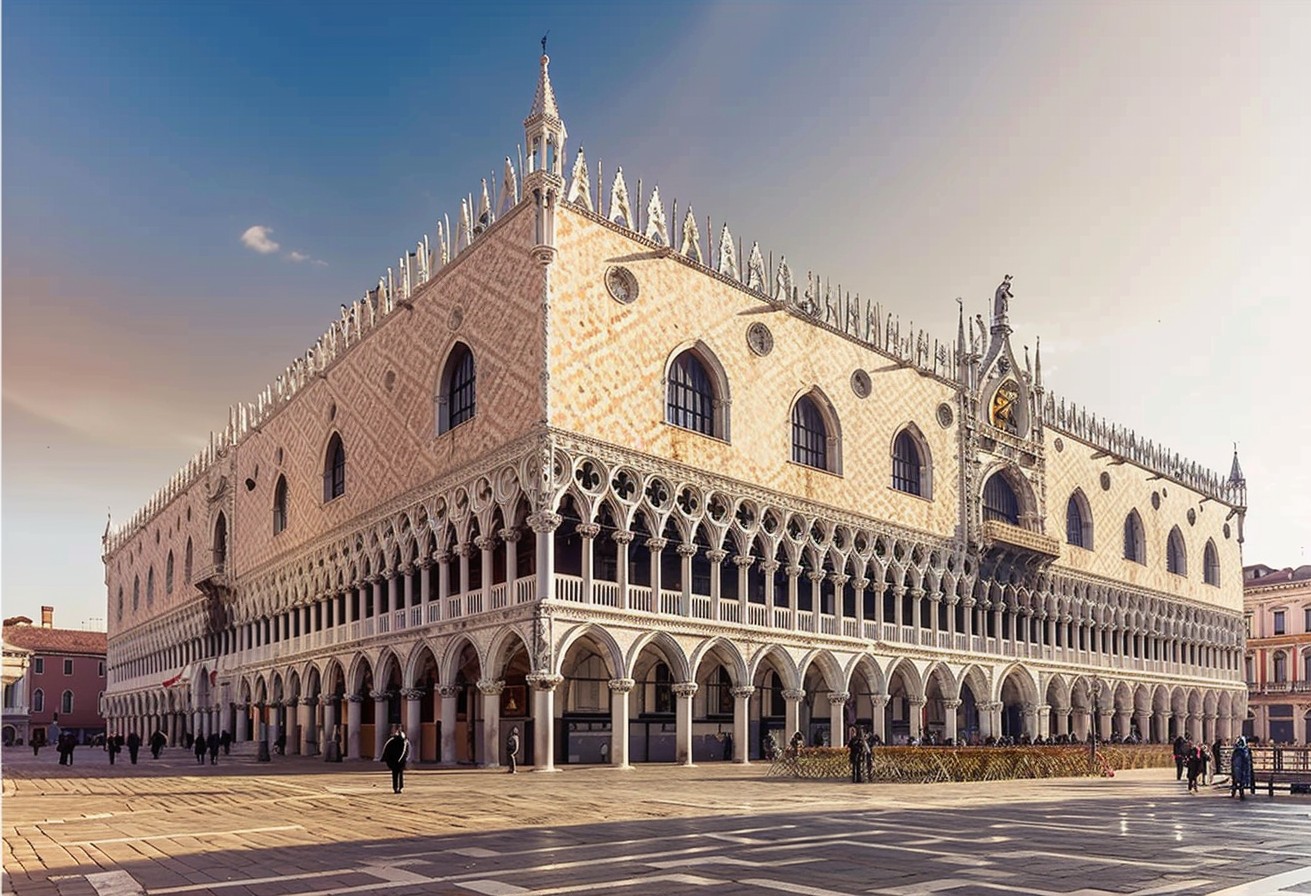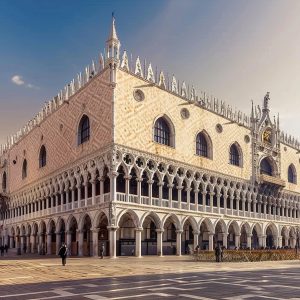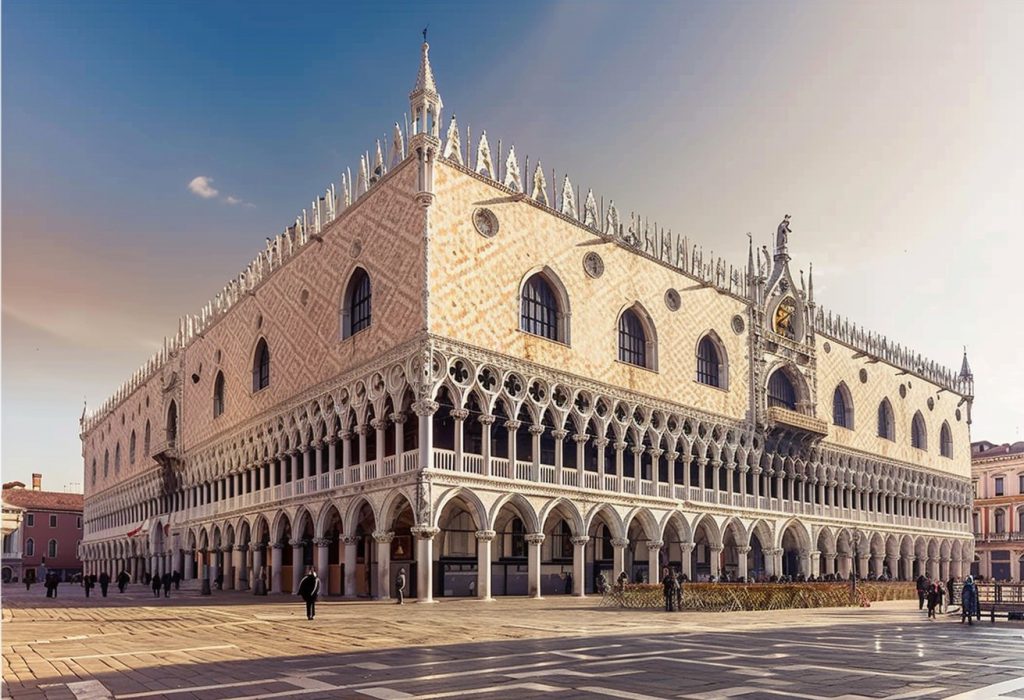Doge’s Palace Venice: What to Know and What to See
- 6 min read
Venice is the city of canals and historic palaces. The Doge’s Palace is one of the city’s most important architectural jewels: this masterpiece of Gothic art stands majestically on the Grand Canal, bearing witness to centuries of history and political power.


Venice 11 Museum Pass + Skiptheline Entry to Doge's Palace
The Origins and the First Doges
The roots of the Doge’s Palace date back to the 9th century when the city of Venice began to take shape as an autonomous center. The first core of the palace was built in Rialto, symbolizing the growing independence of the city. Over the centuries, the palace was expanded and enriched, becoming the center of Venetian political power.

The Ancient Castle and the First Reconstructions
The earliest evidence of the ancient palace dates back to the 10th-11th centuries when the building suffered a fire and was partially destroyed. The reconstruction took place under Doge Sebastiano Ziani, who radically restructured the entire area of St. Mark’s Square, adding new buildings and adapting the structure to the political and economic needs of the time.
Architecture of the Doge’s Palace: The 14th-Century Palace
An important expansion of the Doge’s Palace took place at the end of the 13th century when the number of members of the Great Council increased significantly. The renovation work began under Doge Bartolomeo Gradenigo and lasted for decades, giving rise to the current appearance of the building. Decorative and architectural elements typical of the time characterize the facade and interiors of the palace.
Restorations and Subsequent Transformations
Over the centuries, the Doge’s Palace underwent several restorations and transformations due to fires and political changes. The most significant interventions took place under Doge Francesco Foscari and later with the addition of new wings and Renaissance decorations. The building was enriched with works of art and architectural details, becoming one of the symbols of the power and magnificence of the Republic of Venice.
In conclusion, the Doge’s Palace represents not only a masterpiece of Gothic architecture but also the pulsating heart of Venice’s political and administrative life for centuries. Thanks to its sumptuous interiors and millennia-old history, the Doge’s Palace continues to enchant and amaze visitors from all over the world, offering an unforgettable journey into the glorious past of the Serenissima.
The Visit Itinerary
The Doge’s Palace in Venice is a veritable labyrinth of rooms and corridors that narrate centuries of history and culture. The visit itinerary will lead you through the Museum of the Opera, the courtyard and Loggias, the Doge’s Apartment, the Institutional Rooms, the Picture Gallery, the Prisons, and the Armory.
The Museum of the Opera
The Opera, formerly known as the fabbriceria or procuratoria, was responsible for the maintenance and management of the Doge’s Palace. The Museum of the Opera houses a collection of sculpted capitals that adorned the medieval facades of the building. These works of art tell allegorical, religious, moral, and political stories, offering visitors a journey through Venetian time and culture.
The Courtyard and Loggias
The courtyard and Loggias of the Doge’s Palace are a true architectural jewel, enriched with columns and capitals that narrate the greatness of the Republic of Venice. Here you can admire the sculptures and reliefs that adorn the facades of the building, immersing yourself in Venetian history and art.
The Institutional Rooms
The Institutional Rooms of the Doge’s Palace are the heart of the political power of the Most Serene Republic of Venice. Official ceremonies and meetings of the Great Council, the Venetian parliament, were held here. The rooms are richly decorated with paintings, tapestries, and period furniture, offering visitors an immersion in the political and administrative life of the Republic.
The Picture Gallery
The Picture Gallery of the Doge’s Palace houses a collection of paintings by Venetian and foreign artists, representing the main historical and political events of the Republic of Venice. Here you can admire works by Tintoretto, Veronese, Bellini, and many others, narrating the greatness and beauty of Venice.
The prisons
The Prisons of the Doge’s Palace are a mysterious and evocative place, where the political prisoners of the Republic of Venice were held. The cells are connected by a bridge that crosses the Grand Canal, offering prisoners a unique view of the Venetian lagoon. A place full of history and mystery that will make you relive the stories of prisoners from the past.
The Doge’s Apartment
The Doge’s Apartment was always located in this wing of the Doge’s Palace, near the rio della Canonica, the current Golden Staircase, and the Ducal Chapel. After a fire in 1483, it was rebuilt in a Renaissance style. The reception rooms, with wood-carved ceilings, monumental marble fireplaces, and painted decorations, were part of this reconstruction. The private rooms, about twenty, were distributed in the mezzanines above and below the main floor. Although prestigious, the apartment was not extensive, and it was not uncommon for a Doge to have a more luxurious home in his original residence. Today, the reception rooms feature panels and technological systems that allow for a dynamic experience, hosting works from the collections of the Civic Museums of Venice. This itinerary illustrates the historical and iconographic evolution of the Doge and the symbols of the city.
The Armory
The Armory of the Doge’s Palace is a museum that preserves weapons and ammunition from various eras, once managed by the Council of Ten. After the Republic of Venice, part of the collection was dispersed, but today it has over two thousand pieces. The rooms display armors, swords, crossbows, and other relics, such as a Turkish standard captured at Lepanto and the armor of Henry IV of France. Each room tells a story: from the figure of Gattamelata to the presence of Francesco Morosini, with numerous references to the power of the Council of Ten. The collection also includes prohibited weapons and torture instruments, offering a complete overview of Venetian military history.
A visit to the Doge’s Palace in Venice is an unforgettable experience that will allow you to immerse yourself in the history and art of one of Italy’s most fascinating cities. Discover the secrets and wonders of this extraordinary building, and let yourself be carried away by the beauty and grandeur of the Serenissima Republic of Venice.
